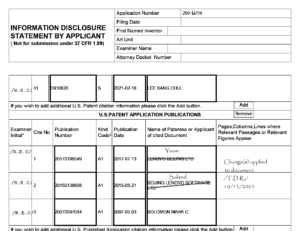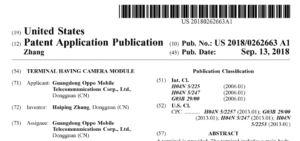
Some practitioners have noticed that there has been a clerk in the Issue Branch who tirelessly marks up IDSs as shown at right. The clerk’s initials are TDR.
The USPTO has now burden-shifted this markup task to applicants, and wrongly so.
What happens is, a patent application gets allowed and the case reaches the Issue Branch. What has happened next, starting in 2013 and continuing until a few months ago, is that clerk TDR would review every IDS that had been filed in the case to see if the practitioner committed a faux pas by citing a US patent publication using the (non-inventor) applicant name instead of the inventor name. The USPTO is, apparently, extremely old-fashioned about stuff like this. There must be a large number of old-timers within the USPTO who even now refuse to accept that under the AIA, an applicant might actually be some entity other than the inventors.
So anyway, to placate those old-timers who cannot accept that somebody other than the inventors could ever be the applicant, this clerk TDR has spent the past ten years tirelessly reviewing every allowed US patent application to look for such faux pas. And, as you can see above, in one of our cases the clerk TDR marked up the IDS so that the citation to US patent publication number US20170199549A1 lists the inventor “Yeom” instead of the applicant “Lenovo Beijing Ltd.”
So I guess what must have happened is that somebody at the USPTO decided the right thing to do is to shift this burden over to the practitioner. One of our applications recently got allowed and in the Notice of Allowance, the Examiner lined through one of our references in an IDS, namely our citation of US patent publication number US20180262663A1. The Examiner’s stated reason for lining through the reference is that we had cited the reference by applicant name instead of inventor name. The Examiner cited 37 CFR § 1.98(b) as the purported authority for the lining-through. Here is the lining-through by the Examiner:

The alert reader already knows that 37 CFR § 1.98(b) does not authorize such lining-through. 37 CFR § 1.98(b)(2) says:
Each U.S. patent application publication listed in an information disclosure statement shall be identified by applicant, patent application publication number, and publication date.
(emphasis added.) As may be seen, in US patent publication number US20180262663A1 the applicant is indeed Guangdong Oppo Mobile Telecommunications Corp Ltd. Here is the front page of the US patent publication number US20180262663A1:

As may be seen, we did not fail to comply with 37 CFR § 1.98(b) with respect to the citation of US patent publication number US20180262663A1. The Examiner was wrong to line through our citation in the IDS.
This mistake by the Examiner forced us to prepare and mail out a request for a corrected Notice of Allowance with no line-through of the US patent publication number US20180262663A1.
There cannot possibly be any cogent reason for the USPTO to bust our chops for using the (non-inventor) applicant name rather than the inventor name in a citation of a US patent publication. Yet that is exactly what the Examiner did — busting our chops. From the point of view of a bibliographic citation, any name appearing on the front page of the document (inventor or non-inventor applicant or even assignee) would be more than adequate for the purpose of identifying the document being cited. And from the point of view of the actual rule that controls, we are in fact specifically directed by the rule to use the applicant name rather than the inventor name.
The only conceivable reason for the Examiner busting our chops on this is that some people within the USPTO even now in 2024 refuse to accept the change that happened in 2013, namely that it became possible for an applicant to be someone other than the inventors.
Have you, like us, been on the receiving end of an Examiner requiring that you “correct” a lined-through IDS to list an inventor name rather than the (non-inventor) applicant name for a US patent publication? If so, please post a comment below.
I will post a followup to let readers know the results of our having filed a request for a corrected Notice of Allowance.

And EVERY 892 I’ve ever seen containing US citations from an examiner continues to identify the art by the inventor’s name, not the applicant. This means if the applicant needs to cite that reference in another related case, the applicant must look up the applicant so that the new IDS can satisfy the text of 37 CFR § 1.98(b), only to have a feckless examiner then object that the new IDS doesn’t identify the inventor.
TYFNIL, is there a chance that an applicant who identifies a reference with the inventor instead of the applicant could be accused of inequitable conduct for not having complied with 37 CFR § 1.98(b)?
One wonders why the PTO didn’t just change 37 CFR § 1.98(b) to say “applicant or inventor.”
Thank you for commenting. In my view, the applicant-friendly path would be for the PTO to change all three lines of 37 CFR § 1.98 to say “applicant or inventor”. Any bib-data name that appears on the front page of the cited document would serve the purpose of helping to identify the document.
37 CFR 1.98(b)(1)-(3) states as follows:
(b)(1) Each U.S. patent listed in an information disclosure statement must be identified by inventor, patent number, and issue date.
(2) Each U.S. patent application publication listed in an information disclosure statement shall be identified by applicant, patent application publication number, and publication date.
(3) Each U.S. application listed in an information disclosure statement must be identified by the inventor, application number, and filing date.
(b)(1) and (3) refer to “inventor,” while b(2) refers to “applicant”, so that’s inconsistent. Clearly the USPTO wants the inventor in all three cases, so it’s probably best to give it to them to avoid problems like this. We always list the inventor’s name for PGPUBS and have never had a problem as far as I know. Sometimes it’s better to light a candle than curse the darkness.
Thank you for commenting. You say “clearly the USPTO wants the inventor in all three cases” but there is no single voice from the USPTO that communicates any single view on this. The part of the USPTO that actually promulgates rules under the APA did not communicate such a want, instead specifying “applicant” as the “wanted” name for US patent publications. The part of the USPTO that does not want to negotiate with the Examiner’s union about what credit would have to be given in the next contract negotiation for retraining all of the Examiners to use post-AIA law (in which applicants can be non-inventors) is probably the strongest voice here. We see this, as Richard correctly points out, in the Examiner behavior in which inventor names get used (despite the AIA having occurred) in the 892s. I suspect part of what’s really going on is, for some in USPTO management, an anti-EPO bias. The EPO, from its founding in 1978, cited documents by applicant name, not inventor name. If the EPO does something in a particular way that differs from what the USPTO historically did, then it’s presumptively wrong, says this institutional bias.
MPEP 609(a)(4)(I) (yes, I know the MPEP does not have the force of law) states as follow on MPEP page 600-220 (left column):
U.S. patent application publications must be identified by the applicant, patent application publication number, and publication date. The Office will also accept a citation in an IDS where a U.S. patent application publication is identified using the inventor instead of the applicant.
Thus, the USPTO recognizes the discrepancy. They should have changed 37 CFR 1.98(b)(2) to say inventor rather than applicant if that is what they want.
At the time TDR marks ups the IDS as shown, the IDS has already been reviewed and initialed by the examiner, has it not? So, what is the effect of this deletion other than not being listed on the issued patent if TDR’s action is not caught in time?
Thank you for commenting! You make a very good point. TYFNIL one could imagine getting favorable summary judgment on this point prior to trial.
1) TDR does not delete the citation. TDR’s note says “change(s) applied to document.” Presumably, the name of the (non-inventor) applicant is changed to the name of the inventor in the issued patent, although I have never remembered to check.
This is not a strike-through like Carl had in his recent Notice of Allowance, which actually does require some action on the part of the applicant.
2) What is really annoying is that the wording on the actual USPTO IDS form says “Name of Patentee or Applicant of cited document” in the appropriate column under “US . . . Publications.” It doesn’t even include “Inventor” as an option!
3) And who exactly is the patentee for a published application? Doesn’t a patent have to issue before anyone could hold/own a patent? And once it does issue, wouldn’t the patentee be the applicant, if there is a non-inventor applicant? Inventors who assign their rights before issue cannot properly be called patentees, can they?
Svihla> MPEP 609(a)(4)(I) (yes, I know the MPEP does not have the
Svihla> force of law) …
The MPEP is binding against the PTO on issues where the MPEP states a rule in favor of the applicant. Fully explained in
SSRN: https://ssrn.com/abstract=3258694
Yes, I know that, too. I hate citing the MPEP because someone is always going to give me grief about it.
For this former USPTO insider’s POV on this topic, see
https://www.linkedin.com/posts/julie-burke-492264120_uspto-shifts-another-burden-to-applicants-activity-7192890281334050816-Jr0v?utm_source=share&utm_medium=member_desktop
Professor:
The PTO/SB/08a (1-22) form the USPTO WANTS us to use, states clearly in column 6 – “Name of Patentee or Applicant of cited Document.” Why are we getting busted for giving them what they want!?!?!
I recently received a NOA with the following:
Information Disclosure Statement
The information disclosure statement filed on 29 May 2023 does not fully comply with the requirements of 37 CFR 1.98(b) because:
Each U.S. patent listed in an information disclosure statement must be identified by inventor, and the references lined through (lines 2 — 7 in the IDS) are instead identified by the assignee company (i.e., line 2 U.S. Patent Dxxx,xxx should be identified with the inventor, xxxxxxx, and not by the assignee, xxxxxxxxx.) (37 CFR 1.98(b)(1)).
Since the submission appears to be bona fide, applicant is given ONE (1) MONTH from the date of this notice to supply the above-mentioned omissions or corrections in the information disclosure statement. NO EXTENSION OF THIS TIME LIMIT MAY BE GRANTED UNDER EITHER 37 CFR 1.136(a) OR (b). Failure to timely comply with this notice will result in the above-mentioned information disclosure statement being placed in the application file with the non-complying information not being considered. See 37 CFR 1.97(i).
The Examiner lined out the “bad” references. What is she going to do after I submit the revised IDS? Reopen the case? This is nuts.
Indeed, when using the USPTO’s magic form, would not all of the references be pulled up for the Examiner? Isn’t that the reason the USPTO wants us to use the form? Shouldn’t a citation to just the number be sufficient to prepopulate at least the US references?
In the continuing saga of inane PTO rules targeting Chinese applicants, one recent OED Final Order on their FOIA website makes mention of violations of the “H-signature method for trademark applications”. WHAT ON EARTH IS THIS ???
cite?